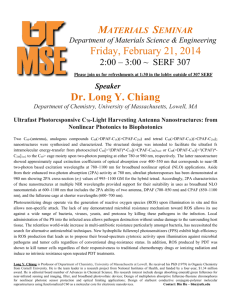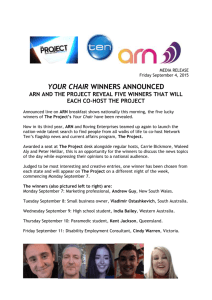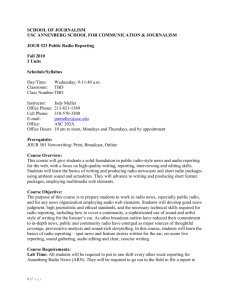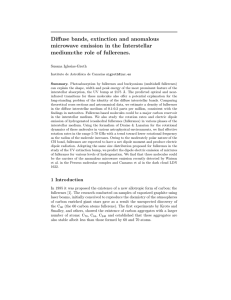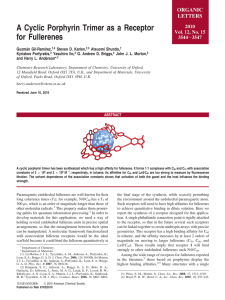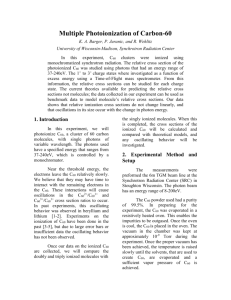left field science, by Sir Harold Kroto
advertisement
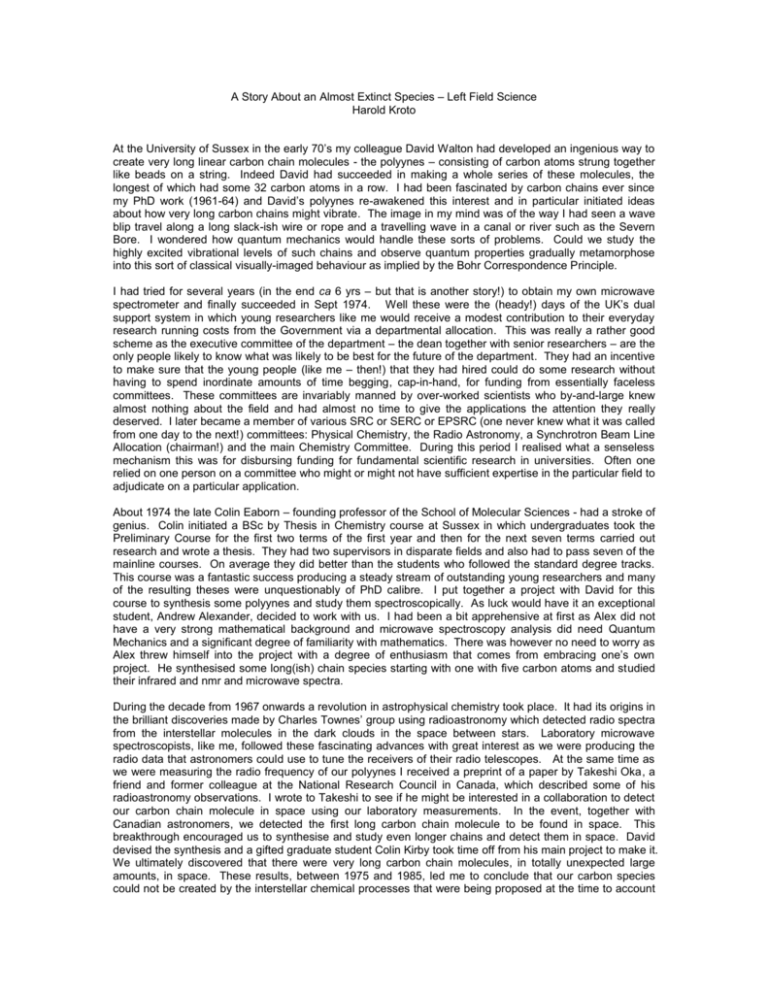
A Story About an Almost Extinct Species – Left Field Science Harold Kroto At the University of Sussex in the early 70’s my colleague David Walton had developed an ingenious way to create very long linear carbon chain molecules - the polyynes – consisting of carbon atoms strung together like beads on a string. Indeed David had succeeded in making a whole series of these molecules, the longest of which had some 32 carbon atoms in a row. I had been fascinated by carbon chains ever since my PhD work (1961-64) and David’s polyynes re-awakened this interest and in particular initiated ideas about how very long carbon chains might vibrate. The image in my mind was of the way I had seen a wave blip travel along a long slack-ish wire or rope and a travelling wave in a canal or river such as the Severn Bore. I wondered how quantum mechanics would handle these sorts of problems. Could we study the highly excited vibrational levels of such chains and observe quantum properties gradually metamorphose into this sort of classical visually-imaged behaviour as implied by the Bohr Correspondence Principle. I had tried for several years (in the end ca 6 yrs – but that is another story!) to obtain my own microwave spectrometer and finally succeeded in Sept 1974. Well these were the (heady!) days of the UK’s dual support system in which young researchers like me would receive a modest contribution to their everyday research running costs from the Government via a departmental allocation. This was really a rather good scheme as the executive committee of the department – the dean together with senior researchers – are the only people likely to know what was likely to be best for the future of the department. They had an incentive to make sure that the young people (like me – then!) that they had hired could do some research without having to spend inordinate amounts of time begging, cap-in-hand, for funding from essentially faceless committees. These committees are invariably manned by over-worked scientists who by-and-large knew almost nothing about the field and had almost no time to give the applications the attention they really deserved. I later became a member of various SRC or SERC or EPSRC (one never knew what it was called from one day to the next!) committees: Physical Chemistry, the Radio Astronomy, a Synchrotron Beam Line Allocation (chairman!) and the main Chemistry Committee. During this period I realised what a senseless mechanism this was for disbursing funding for fundamental scientific research in universities. Often one relied on one person on a committee who might or might not have sufficient expertise in the particular field to adjudicate on a particular application. About 1974 the late Colin Eaborn – founding professor of the School of Molecular Sciences - had a stroke of genius. Colin initiated a BSc by Thesis in Chemistry course at Sussex in which undergraduates took the Preliminary Course for the first two terms of the first year and then for the next seven terms carried out research and wrote a thesis. They had two supervisors in disparate fields and also had to pass seven of the mainline courses. On average they did better than the students who followed the standard degree tracks. This course was a fantastic success producing a steady stream of outstanding young researchers and many of the resulting theses were unquestionably of PhD calibre. I put together a project with David for this course to synthesis some polyynes and study them spectroscopically. As luck would have it an exceptional student, Andrew Alexander, decided to work with us. I had been a bit apprehensive at first as Alex did not have a very strong mathematical background and microwave spectroscopy analysis did need Quantum Mechanics and a significant degree of familiarity with mathematics. There was however no need to worry as Alex threw himself into the project with a degree of enthusiasm that comes from embracing one’s own project. He synthesised some long(ish) chain species starting with one with five carbon atoms and studied their infrared and nmr and microwave spectra. During the decade from 1967 onwards a revolution in astrophysical chemistry took place. It had its origins in the brilliant discoveries made by Charles Townes’ group using radioastronomy which detected radio spectra from the interstellar molecules in the dark clouds in the space between stars. Laboratory microwave spectroscopists, like me, followed these fascinating advances with great interest as we were producing the radio data that astronomers could use to tune the receivers of their radio telescopes. At the same time as we were measuring the radio frequency of our polyynes I received a preprint of a paper by Takeshi Oka, a friend and former colleague at the National Research Council in Canada, which described some of his radioastronomy observations. I wrote to Takeshi to see if he might be interested in a collaboration to detect our carbon chain molecule in space using our laboratory measurements. In the event, together with Canadian astronomers, we detected the first long carbon chain molecule to be found in space. This breakthrough encouraged us to synthesise and study even longer chains and detect them in space. David devised the synthesis and a gifted graduate student Colin Kirby took time off from his main project to make it. We ultimately discovered that there were very long carbon chain molecules, in totally unexpected large amounts, in space. These results, between 1975 and 1985, led me to conclude that our carbon species could not be created by the interstellar chemical processes that were being proposed at the time to account for interstellar molecules in general. I wondered if the carbon chains might be a special case and most likely produced in the atmospheres of red giant carbon stars and subsequently expelled into the regions of the interstellar medium where we had detected them. During the Easter of 1984 I visited Rice University in Texas at the invitation of my friend and fellow spectroscopist Bob Curl. During this visit Bob suggested that I visit a colleague’s laboratory. During this visit to Rick Smalley’s laboratory, Rick expounded excitedly the way in which his newly created cluster beam machine worked, using a laser to vapourise metals. During his demonstration I began the formulate, in my mind, a project to simulate in the laboratory the conditions I thought might occur in a red giant star and be responsible for the carbon chains we had detected by radioastronomy. I discussed the possibility of a joint project with Bob that evening. Some seventeen months later Bob called me in the UK to say that they were, at last, going to try the experiment and asked whether I was interested in coming to Rice to participate. In the event I did not hesitate, I paid for my own intercontinental air ticket and during the 15 day visit in September 1985 carried out the research with undergraduates Jim Heath, Sean O’Brien and Yuan Liu that resulted in the serendipitous discovery of the C60 molecule. This discovery led ultimately to a whole new field of Organic Chemistry – the Fullerenes, the re-discovery of the carbon nanotubes and the award a Nobel Prize in Chemistry in 1996. For what it is worth Google lists the following - Results: about 588,000 hits for “fullerene” and about 1,440,000 for “nanotube”. This work (now 25 years on) told us that our understanding of carbon chemical processes on a nanoscale was totally wrong - indeed six of the first set of papers published - all by leading US groups in the field of cluster science claimed we were wrong! Fortunately our manuscript went to Nature (UK) and did not go to any of these groups to be refereed! One might hypothesise over the possibility that had we had the (essentially impossible) prescience to submit a research proposal to carry out this study it would almost certainly have gone to some of these groups for “peer review” - and presumably would have been turned down. The discovery of C60 will have its 25th anniversary next year and it is only now that applications appear to be on the horizon. One of the most important properties of C60 is that it is an outstanding electron trap and the commercialisation of organic solar cells doped with fullerenes (which improve the efficiency of electricity production by about an order of magnitude) and printed on inexpensive thin plastic is now imminent. On the medical front the fullerene cages are able to trap biologically toxic atoms inside the cage physically, rather than chemically, and their application as non-toxic MRI imaging and radioactive anti-cancer agents appears also to be imminent. The Mitsubishi Company has invested some $20M in a plant which produces fullerenes by a combustion process in tens of kilogram quantities. It may be worth pointing out that not only did I try to convince some leading combustion scientists that C60 was being produced by combustion but I was vehemently criticised in papers by some of them for suggesting this heresy. In fact applied combustion scientists, who do the sort of “strategic” research so beloved of Mrs Thatcher missed this, should have discovered C60 some 60 years ago. The carbon nanotubes which, as mentioned above, were a spin-off rediscovery from the C60 breakthrough have already found applications and are the focus of developments that promise paradigm-shifting advances in materials engineering and electronics. It is also worth noting that the apparatus at Rice that we used was originally designed to produce species by laser photo-fragmentation of gaseous precursors. However in the initial tests of the system the laser accidentally hit the aluminium wall of the apparatus producing large aluminium clusters efficiently. The apparatus was immediately modified to laser vapourise refractory materials and a major breakthrough in cluster science was born. This is yet another typical example of the way important scientific advances are made serendipitously. In summary none of the three key experiments in this story was part of any research proposal. The initial study was just hatched to understand some fundamental aspects of molecular quantum mechanics and enable an undergraduate to obtain a BSc degree. The second radioastronomy discovery of the large carbon containing molecules in space was also not part of any research proposal but an idea based on the undergraduate project. It was proposed informally in a letter to a former colleague in Canada who happened to have access to a radio telescope. The Nobel Prizewinning discovery of C60 itself was an idea suggested during a chance visit to Rice University and I paid my own air fare to Houston to carry out the experiment myself. It was not in any research proposal either. Furthermore the apparatus used was built to do quite a different experiment. One further point is that six months after I returned to the UK in 1967, my glorified postdoctoral position at Sussex was converted to a tenured lectureship taking a massive weight off my shoulders. Whatever pressure there was for me to succeed at research was pressure I put on myself. Today in the UK the young researchers often spend several years on research fellowships worrying about their future and how they will be able to continue to support their families if they do not make the grade. In the US a similar invidious situation pervades as young scientists with tenure track appointments need to obtain NSF grants or they will be fired. I understand that the success rate is now less than 20%. These really are not conditions conducive to the unfettered mindset necessary for many young people to make the creative advances that are needed for the future of society. Richard Feynman, in Chris Sykes’ wonderful BBC interview, speaks about how important such an unpressured mental environment is for creativity. There may be some lessons here about how some fundamental breakthroughs occur and how strategic or applied science can fail. There may also be lessons to be learned about the peer review process and the impossibility of predicting the major discoveries themselves let alone the future impact of any discoveries. There may be lessons too about the age-old point that time-and-again it is only when discoveries are made that possible applications become obvious and then almost invariably made by scientists in a totally different field from that of the original discoverer. Excellent examples are the applications of lasers to eye surgery and bar-code scanners at supermarket cash desks which I doubt were in the mind of Charles Townes who developed the microwave amplifier by stimulated emission of radiation. I suspect, personally, that in general the mindset of those who are successful at making fundamental breakthroughs in the sciences is fundamentally very different from those of the entrepreneurs who are successful at applications – perhaps even orthogonal in many cases. Whichever way, those who fund research should ponder these facts and the following: In the 70’s a rough notional estimate of the split between overall funding in the UK for fundamental and applied research respectively was ca 15%:85%. Halving the 15% to 7.5% by introducing strategic initiatives was a catastrophic cut in fundamental science. It probably took the level down below the threshold of viability for fundamental science at which the UK appears to have been rather good in the past; it was, arguably, a drop in the ocean for applied research, at which it is arguable that the UK has not been that good. History has shown time-and-again that the basics of the above story are very often the way that important breakthroughs occur. Indeed it is blindingly obvious that the really unexpected and unpredictable discoveries are invariably more important than those that are the result of targeted initiatives. The discovery of C60 was the result of an experiment to understand stellar and interstellar chemistry and thus a totally “Leftfield” breakthrough. This “Left-field Science” is now almost extinct and one might ponder how well a team will do if it cannot field players in left field – or in cricket rather than baseball parlance on the off-side. However my experience is that one can point out the above obvious issues until one is blue-in-the-face, and no one with any influence on science funding ever takes the blind bit of notice!



